Secure in its borders, with hegemony over the Nile Valley and flourishing trade links, the early Egyptian state witnessed a marked rise in overall prosperity, but the rewards were not evenly spread across the population. Cemeteries that span the period of state formation show a sudden polarization of grave size and wealth, a widening gap between rich and poor, with those who were already affluent benefiting the most. The greatest beneficiary by far was the state itself, for the practical effect of political unification was to convey all land into royal ownership. While individuals and communities continued to farm their land as they had before, they now found themselves with a landlord who expected rent in return for their use of his property.
Dr. Paul Nicholson, an archaeologist at Cardiff University in Wales, told the New York Times that new excavations at Amarna had yielded two large furnaces, which I believe are for use in glass production. No such furnaces have so far been uncovered at Qantir, he noted. It is likely that neither Amarna nor Qantir are actually the earliest in Egypt, Nicholson said but the Qantir evidence is important and Thilo has rec
In the Mesopotamian cities, there were 16 main types of tokens and dozens of sub categories for things like honey, trussed duck, sheeps milk, rope, garments, bread, textiles, furniture, mats, beds, perfume and metals.
As agriculture became more advanced, surpluses were generated, freeing farmers to perform other jobs. Over time former farmers could earn enough to specialize in certain tasks and become what would qualify as craftsmen.
Clay tokens, described by some scholars as the worlds first money, found in Susa, Iran have been dated to 3300 B.C. One was equivalent to one sheep. Others represented a jar of oil, a measure of metal, a measure of honey, and different garments.
In the early days of shekels, people carried pieces of metal in bags and amounts were measured out on scales with stones as countermeasures on the other side. Between 2800 B.C. and 2500 B.C., pieces of silver were caste a standard weight, usually in the form of rings or coils calledon tablets. These rings, worth between 1 and 60 shekels, were used primarily by the rich to make big purchases. They came in a number of different forms: large ones with triangular ridges, thin coils.
Writing and Economics in Ancient Egypt
Sometime before 2500 B.C. a shekel of silver became the standard currency. Tablets listed the price of timber and grains in shekels of silver. A shekel was equal to about one third of an ounce, or little more than three pennies in terms of weight. One month of labor was worth 1 shekel. A liter of barely sold for 3/100ths of shekel. A slave sold for between 10 and 20 shekels.
People often fell into debt—a conclusion based on numerous tablet letters describing people in various kinds of trouble for falling into debt. Many debtors became slaves. The situation got so out of hand in Babylon that King Hammurabi decreed that no one could be enslaved for more than three years for debt. Other cities, with residents racked by debt, issued moratoriums on all outstanding bills.
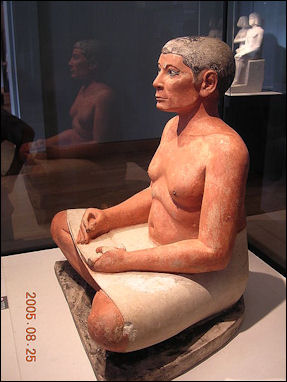
The use of money made trade easier between city-states and kingdoms and well as between Mesopotamia, Egypt and Palestine.
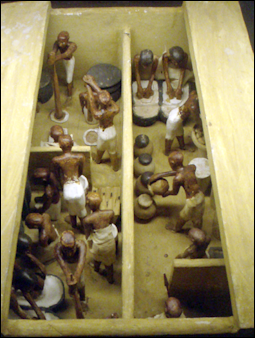
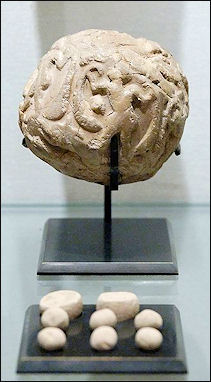
The use of money made trade easier between Mesopotamia, Egypt and Palestine. Archaeologists have also found a crock with bits of gold and silver, including several rod-shaped ingots of gold and silver. Egyptians also paid for things with pieces of gold and silver carried in sacks and jars and measured in deben (a traditional Egyptian measurement equal to three ounces). One deben was equal to a sack of wheat. Four or five could buy a tunic, 50, a cow.
Which is the best price? Its so complex that people dont know if they are getting a good deal. For the first time in history, weve got a large number of goods. And for the first time, we have so many prices that it overwhelms the human mind. People needed some standard way of stating value.
The Egyptian economy in the time of the pyramids was powered the by the construction of the pyramids. Pyramids building required labor. An economy was necessary to pay them.
Development of Money Idea and the Idea Behind it

The Egyptians developed fairly sophisticated chemistry through cosmetic-making, dying, glassmaking and gold and iron metallurgy. Glassmaking was known in ancient Egypt as far back as 2500 B.C. The bottle was invented sometime around 1500 B.C. by Egyptian artisans. Glass from Egypt
The difference between the silver rings used in Mesopotamia and earliest coins first produced in Lydia in Anatolia in the 7th century B.C. was that the Lydian coins had the stamp of the Lydian king and thus were guaranteed by an authoritative source to have a fixed value. Without the stamp of the king, people were reluctant to take the money at face value from a stranger.

In 2005 two archaeologists reported finding such a factory in the ruins of an Egyptian industrial complex from the time of Rameses the Great. The well-known site, Qantir-Piramesses, in the eastern Nile delta, flourished in the 13th century B.C. as a northern capital of the pharaohs. Dr. Thilo Rehren of the Institute of Archaeology at University College London told the New York Times, This is the first ever direct evidence for any glassmaking in the entire Late Bronze Age. **
Many craftsmen and artisans were employed by the state and nobles. Their shops and workshops were often set up near the palaces of the pharaohs, aristocrats or high officials. Their crafts tended to be passed on from one generation to the next
Writing certainly transformed the business of international trade. Many of the labels from the royal tombs at Abdju—whose miniature scenes of royal ritual serve as an important source for early pharaonic culture—were originally attached to jars of high quality oil, imported from the Near East. An upsurge in such imports during the First Dynasty can be associated with the establishment of Egyptian outposts and trading stations throughout southern Palestine. At sites such as Nahal Tillah and Tel Erani in present- day Israel, imported Egyptian pottery (some stamped with the cipher of Narmer), locally made pottery in an Egyptian style, and seal impressions with hieroglyphs testify to the presence of Egyptian officials in the heart of the oil- and wineproducing region. At the springs of En Besor, near modern Gaza, the Egyptian court established its own supply center, for revictualing trade caravans using the coastal route between Palestine and the Nile delta.
Clay accounting tokens from MesopotamiaThe earliest form of trade was barter. The earliest known proto-money are clay token excavated from the floors of villages houses and city temples in the Near East. The tokens served as counters and perhaps as promissory notes used before writing was developed. The tokens came in different sizes and shapes.
A wide variety of copper tools, fish hooks and needles were made. Chisels and knives lost their edge and shape quickly and had be reshaped with some regularity or simply thrown out. In the Old Kingdom (2700 to 2125 B.C.) there was only copper. Copper-making hearths have been found near the pyramids. Reliefs found nearby show Egyptians gathering around a fire smelting copper by blowing into long tubes with bulbous endings.
One well-preserved crucible, Wilford wrote, contained a block of raw glass, and many other vessels held semifinished glass and some fragments that had been colored blue, red and purple. In the June 17, 2005 issue of the journal Science, the two archaeologists reported, We could identify several hundred individual vessels used in glassmaking and coloring; more than 90 percent of these are crucibles, the rest being jars. [Source:John Noble Wilford, New York Times, June 21, 2005 **]
When it came to collecting taxes, in the form of a proportion of farm produce, we must assume a network of officials operated on behalf of the state throughout Egypt. There can be no doubt that their efforts were backed up by coercive measures. The inscriptions left by some of these government officials, mostly in the form of seal impressions, allow us to re-create the workings of the treasury, which was by far the most important department from the very beginning of Egyptian history. Agricultural produce collected as government revenue was treated in one of two ways. A certain proportion went directly to state workshops for the manufacture of secondary products—for example, tallow and leather from cattle; pork from pigs; linen from flax; bread, beer, and basketry from grain. Some of these value- added products were then traded and exchanged at a profit, producing further government income; others were redistributed as payment to state employees, thereby funding the court and its projects. The remaining portion of agricultural produce (mostly grain) was put into storage in government granaries, probably located throughout Egypt in important regional centers. Some of the stored grain was used in its raw state to finance court activities, but a significant share was put aside as emergency stock, to be used in the event of a poor harvest to help prevent widespread famine. Whether this represented genuine altruism or practical self- interest on the part of the state depends on ones point of view. The people as a whole certainly benefited from this national insurance policy, but at a cost to themselves. This, of course, is the enduring truth about taxes.
In Mesopotamia, silver became the standard of value sometime between 3100 B.C. and 2500 B.C. along with barley. Silver was used because it was a prized decorative material, it was portable and the supply of it was relatively constant and predictable from year to year.
The governments ambition to control every aspect of the national economy is underlined by two measures introduced in the First Dynasty. Both are attested on the Palermo Stone, a fragment of royal annals that were compiled in the Fifth Dynasty, around 2400, and stretched back to the beginning of recorded history. The earliest surviving entry, for a First Dynasty king, probably Narmers immediate successor, Aha, concerns an event called the Following of Horus, which evidently took place every two years. Most probably, it consisted of a journey by the king and his court along the Nile Valley. In common with the royal progresses of Tudor England, it would have served several purposes at once. It allowed the monarch to be a visible presence in the life of his subjects; enabled his officials to keep a close eye on everything that was happening in the country at large, implementing policies, resolving disputes, and dispensing justice; defrayed the costs of maintaining the court, and removed the burden of supporting it year- round in one location; and, last but by no means least, facilitated the systematic assessment and levying of taxes. (A little later, in the Second Dynasty, the court explicitly recognized the actuarial potential of the Following of Horus. Thereafter, the event was combined with a formal census of the countrys agricultural wealth.) From the third reign of the First Dynasty, the Palermo Stone also records the height of the annual Nile inundation, measured in cubits and fractions of a cubit (one ancient Egyptian cubit equals 20.6 inches). The reason why the court would have wished to measure and archive this information every year is simple: the height of the inundation directly affected the level of agricultural yield the following season, and would therefore have allowed the royal treasury to determine the appropriate level of taxation.
Among those that worked in trades and professions in ancient Egyptian were: barbers, potters, arrow makers, merchants, basket makers, record keepers, tool and weapons makers, goldsmiths, silversmiths, butchers, stonemasons, water carriers, fishermen, estate workers, farmers, tanners, weavers, boatbuilders, furniture makers, bakers, metal workers, pottery makers, beer brewers, bread makers, leatherworkers, spinners, weavers, clothes makers and jewelers.
Archaeologists have had a difficult time sorting out information on ancient money because, unlike pottery or utensils, found in abundant supply at archeological sites, they didnt thrown them out.
Tax collectors punished deadbeats by beating and flogging and torturing to death. Peasants were sometimes bound by their hands and feet and thrown into the irrigation ditches to drown. A tomb painting, dated around 2400 B.C., shows a tax official meeting with a group who hadnt paid their taxes. The next scene shows some of them being flogged.
It is likely that the idea of writing came to Egypt along with a raft of other Mesopotamian influences in the centuries before unification—the concept, but not the writing system itself. Hieroglyphics are so perfectly suited to the ancient Egyptian language, and the individual signs so obviously reflected the Egyptians particular environment, that they must represent an indigenous development. We may imagine an inspired genius at the court of one of Egypts predynastic rulers pondering the strange signs on imported objects from Mesopotamia—pondering them and their evident use as encoders of information, and devising a corresponding system for the Egyptian language. This may seem farfetched, but the invention of the Korean script (by King Sejong and his advisers in a.d. 1443) provides a more recent parallel, and there are few other entirely convincing explanations for the sudden appearance of fully fledged hieroglyphic writing.
Organized labor was also needed to build other structures, quarry stone, mine precious metals and stones and build and maintain irrigation canals and other water projects. The Egyptians built many canals and irrigations systems. They didnt make so many roads. Roads were not so important because they relied on the Nile for transportation. The Egyptian economy in the time of the pyramids was powered the by the construction of the pyramids. Pyramids building required labor. An economy was necessary to pay them.
Early tools were made from copper and later bronze. Egyptian bronze tended to be around 88 percent copper and 12 percent tin. Iron was introduced by the Hittites in the 13th century but wasnt common until the 6th or 7th century B.C.
Fraud and cheating were so prevalent in the ancient world that there are eight passages in the Old Testament that forbid tampering with scales or substituting lighter for heavier stones.
Being a scribe was considered a good job. Dr. Carol R. Fontaine, an assistant professor of Old Testament at the Andover Newton Theological School in Massachusetts, told the New York Times, that, according to papyri that have been translated, the scribes regarded writing as a good way to make a living, much better than being potterymakers (who were smeared with soil, like one whose relations have died), merchants (who spent all their time in river travel), watchmen (who suffered bad hours), shoemakers (who forever had red hands) and soldiers (who drank bad water, marched up hills a lot and ran the risk of getting killed). See Scribes Under People and Life, Language
Other experts familiar with the research said the findings were important for reconstructing the ancient technology of glassmaking. But some questioned the claim that Qantir represented the first evidence of primary glass production, citing previous findings in Egypt at Amarna, which are dated a century earlier. Dr. Rehren and Dr. Edgar B. Pusch of the Pelizaeus Museum in Hildesheim, Germany, said they had excavated cylindrical crucibles and remains of glass raw materials in various stages of production. The site yielded samples of quartz grains, thought to be the main silica source of glassmaking in the Bronze Age. **
Early Mesopotamians who lived in the Fertile Crescent before the rise of the first cities employed five token types that represented different amounts of the three main traded goods: grain, human labor and livestock such as goats and sheep.
Pottery making was well advanced by 3000 B.C. The earliest Egyptian pottery was unglazed red earthenware. Both Mesopotamia and ancient Egypt had the pottery wheel by that time. The potters wheel is believed to have been invented in Mesopotamia around 3500 B.C. and may be tied to the invention of wheeled vehicles. See Mesopotamia.
The archaeologists concluded that this was a large-scale glassmaking operation. In the first step of production, a mixture of crushed quartz and plant ash was heated at a low temperature in ceramic vessels. Salt contaminants were then washed away from the semifinished glass. Next, the glass powder was mixed with coloring minerals and heated inside the crucibles. At the end, the containers would have been smashed to remove the glass ingots. Dr. Caroline M. Jackson, an archaeologist at the University of Sheffield in England, said the new finds convincingly show that the Egyptians were making their own glass in large specialized facilities that were under royal control. **
Sculptures made of copper, bronze and other metals were cast using the lost wax method which worked as follows: 1) A form was made of wax molded around a pieces of clay. 2) The form was enclosed in a clay mold with pins used to stabilize the form. 3) The mold was fired in a kiln. The mold hardened into a ceramic and the wax burns and melted leaving behind a cavity in the shape of the original form. 4) Metal was poured into the cavity of the mold. The metal sculpture was removed by breaking the clay when it was sufficiently cool.
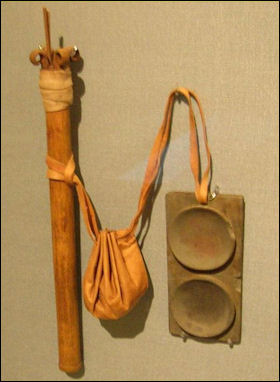
There were no coins or paper money in ancient Egypt. Workers tended to be paid in food, drink, oil, dried and other goods and services rather than money. Egyptians used animals, particularly sheep, for money. Gold pieces have been found that are shaped like sheep. These are believed to have been early money.
Toby Wilkinson wrote inThe Rise and Fall of Ancient Egypt, The First Dynasty government lost no time in devising and imposing a nationwide system of taxation, to turn the countrys agricultural productivity to its own advantage. Once again, writing played a key role. From the very beginning of recorded history, the Egyptian government used written records to keep accounts of the nations wealth and to levy taxes. Some of the very earliest ink inscriptions—on pottery jars from the time of Narmer—refer to revenue received from Upper and Lower Egypt. It seems that, for greatest efficiency, the country was already divided into two halves for the purposes of taxation. . [Excerpt The Rise and Fall of Ancient Egypt by Toby Wilkinson, Random House, 2011, from the New York Times, March 28, 2011]
, Among the great inventions of human history, writing has a special place. Its transformative power—in the transmission of knowledge, the exercise of power, and the recording of history itself—cannot be overstated. Today, it is virtually impossible to imagine a world without written communication. For ancient Egypt, it must have been a revelation. We are unlikely ever to know exactly how, when, and where hieroglyphics were first developed, but the evidence increasingly points toward a deliberate act of invention. The earliest Egyptian writing discovered to date is on bone labels from a predynastic tomb at Abdju, the burial of a ruler who lived around 150 years before Narmer. These short inscriptions already used fully formed signs, and the writing system itself showed the complexity that would characterize hieroglyphics for the next three and a half thousand years. Archaeologists dispute whether Egypt or Mesopotamia should take the credit for inventing the very idea of writing, but Mesopotamia, especially the southern city of Uruk (modern Warka), seems to have the better claim. Excerpt The Rise and Fall of Ancient Egypt by Toby Wilkinson, Random House, 2011, from the New York Times, March 28, 2011
Early Man and Ancient History – Ancient Egyptian Life, Culture, Politics and Economics
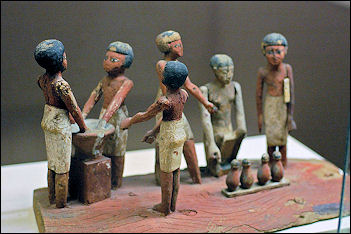
Some archaeologists suggest that money was used by wealthy citizens of Mesopotamia as early as 2,500 B.C., or perhaps a few hundred years earlier. Historian Marvin Powell of Northern Illinois in De Kalb told Discover, Silver in Mesopotamia functions like our money today. Its a means of exchange. People use it for storage of wealth, and the use it for defining value. [Source: Heather Pringle, Discover, October 1998]
Silver rings were used in Mesopotamia and Egypt as currency hundreds of years before the first coins were struck. A wall painting from Thebes from 1,300 B.C. shows a man weighing donut-size gold rings on a balance.
ANCIENT EGYPTIAN ECONOMICS, MONEY, TRADE AND INDUSTRY
Knives tended be made from bronze. They were considerably sharper than copper knives. The sharpest knives of all were made of flaked obsidian. A wide variety of stone tools were also used, including pick axes and hammers.
from MesopotamiaThomas Wyrick, an economist at Southwestern Missouri State University told Discover, If there were a thousand different goods being traded up and down the street, people could set the price in a thousand different ways because in a barter economy each good is priced in terms of other goods. So one pair of sandals equals ten dates, equals one quart of wheat, equals two quarts of bitumen, and so on.
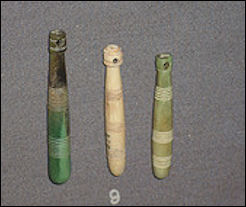
Whereas Egypts relationship with the Near East was, from the start, contradictory and complex, its attitude toward Nubia—the Nile Valley south of the first cataract—was far more straightforward . . . and domineering. Before the beginning of the First Dynasty, when the predynastic kingdoms of Tjeni, Nubt, and Nekhen were rising to prominence in Egypt, a similar process was under way in lower (northern) Nubia, centered on the sites of Seyala and Qustul. With a sophisticated culture, kingly burials, and trade with neighboring lands, including Egypt, lower Nubia displayed all the hallmarks of an incipient civilization. Yet it was not to be. The written and archaeological evidence tell the same story, one of Egyptian conquest and subjugation. Egypts early rulers, in their determination to acquire control of trade routes and to eliminate all opposition, moved swiftly to snuff out their Nubian rivals before they could pose a real threat.
Toby Wilkinson wrote inThe Rise and Fall of Ancient Egypt, Ideology is never enough, on its own, to guarantee power. To be successful over the long term, a regime must also exercise effective economic control to reinforce its claims of legitimacy. Governments seek to manipulate livelihoods as well as lives. The development in ancient Egypt of a truly national administration was one of the major accomplishments of the First to Third dynasties, the four- hundred- year formative phase of pharaonic civilization known as the Early Dynastic Period (2950-2575). At the start of the period, the country had only just been unified. Narmer and his immediate successors were faced with the challenge of ruling a vast realm, stretching five hundred miles from the heart of Africa to the shores of the Mediterranean. By the close of the Early Dynastic Period, the government presided over a centrally controlled command economy, financing royal building projects on a lavish scale. Just how this was achieved is a story of determination, innovation, and, above all, ambition..[Source: Excerpt The Rise and Fall of Ancient Egypt by Toby Wilkinson, Random House, 2011, from the New York Times, March 28, 2011]
Archaeologists generally credit Mesopotamia as the original and primary source of glass, as early as the 16th century B.C.. But no factories have been uncovered there. More than a century ago, the British archaeologist Flinders Petrie discovered what he considered evidence of Bronze Age glass production at Amarna. The site is dated to the 14th-century reign of Akhenaten and therefore earlier than Qantir. But skeptics suspected that the Amarna glassworks was not a production plant, only a place where glass ingots were reworked into finished goods. And if it was a primary factory, why would records show Akhenaten requesting that glass be shipped to Egypt? **
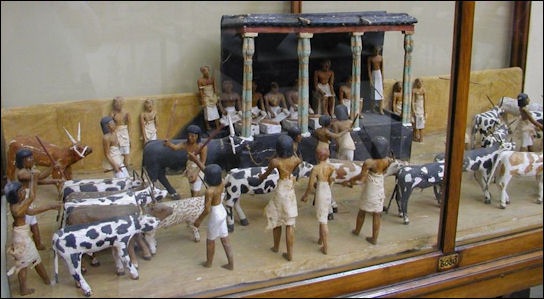
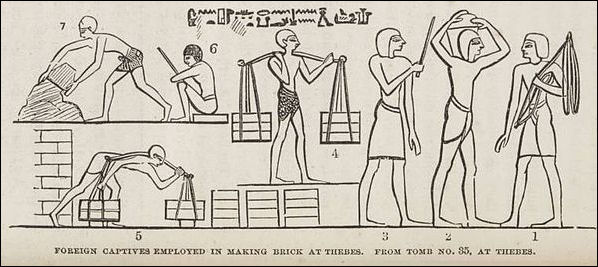
To pay their bills ordinary people used less valuable money made of tin, copper or bronze. Barley was also used as currency. The advantage with it was that small weighing errors made little difference and it was difficult to cheat someone.
No long after shekels appeared as a means of exchange, kings began levying fines in shekels as a punishment. Around 2000 B.C., in the city of Eshnunna, a man who bit another mans nose was fined 60 shekels. A man who slapped another man in the face had to pay up 20 shekels.
A 3,700-year-old tablet from the Euphrates River town of Sippar recorded a bill of sale of a woman who bought some land with a silver ring, worth the equivalent of 60 months wages for an ordinary worker, that she received from her parents.
The main problem with silver is that it was so valuable that weighing errors or impure silver should translate to a large amount of lost value. Some people tried to purposely cheat others by adding other metals into gold or silver or even substituting look-a-like metals.
Under state sponsorship, Egypts international relations entered a new period of dynamism—not that you would have guessed it from the official propaganda. For domestic consumption, the Egyptian government maintained a fiction of splendid isolation. According to royal doctrine, the kings role as defender of Egypt (and the whole of creation) involved the corresponding defeat of Egypts neighbors (who stood for chaos). To instill and foster a sense of national identity, it suited the ruling elite—as leaders have discovered throughout history—to cast all foreigners as the enemy. An ivory label from the tomb of Narmer shows a Palestinian dignitary stooping in homage before the Egyptian king. At the same time, in the real world, Egypt and Palestine were busy engaging in trade. The xenophobic ideology masked the practical reality. This should serve as a warning for the historian of ancient Egypt: from earliest times, the Egyptians were adept at recording things as they wished them to be seen, not as they actually were. The written record, though undoubtedly helpful, needs careful sifting, and must always be weighed against the unvarnished evidence dug up by the archaeologists trowel.
Whatever the circumstances of its invention, writing was swiftly embraced by Egypts early rulers, who recognized its potential, not least for economic management. In the context of competing kingdoms expanding their spheres of influence, the ability to record the ownership of goods and to communicate this information to others was a marvelous innovation. Straightaway, supplies entering and leaving the royal treasury began to be stamped with the kings cipher (his Horus name). Other consignments, destined for his tomb, had labels attached to them, recording not just ownership but other important details such as contents, quantity, quality, and provenance. Having been developed as an accounting tool, writing found an enthusiastic reception among bureaucratically minded Egyptians. Throughout ancient Egyptian history, literacy was reserved for a tiny elite at the heart of government. To be a scribe—to be able to read and write—was to have access to the levers of power. That association was evidently formed at the very start.
John Noble Wilford wrote in the New York Times, In Egypt and the rest of the Middle East in the 13th century B.C., bronze was the heavy metal of power, and glass the rare commodity coveted by the powerful, who treasured glass jewelry, figurines and decorative vessels and exchanged them as prestige gifts on a par with semiprecious stones. But definitive evidence of the earliest glass production long eluded archaeologists. They had found scatterings of glassware throughout the Middle East as early as the 16th century B.C. and workshops where artisans fashioned glass into finished objects, but they had never found an ancient factory where they were convinced glass had been made from its raw materials. [Source:John Noble Wilford, New York Times, June 21, 2005 **]
Writing in an accompanying journal article, Dr. Jackson noted that at Qantir, copper was used to color glass either red or blue, a relatively difficult process, and that glass ingots were the end product. This seemed to settle a dispute among scholars: whether the Egyptians at this time were able to produce and export glass, or only rework glass into luxury goods, like colorful beads and containers for perfumes. **